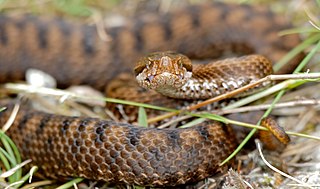
Echis carinatus, known as the saw-scaled viper, Indian saw-scaled viper, little Indian viper, and by other common names, is a viper species found in parts of the Middle East and Central Asia, and especially the Indian subcontinent. It is the smallest member of the "big four" Indian snakes that are responsible for causing the most snakebite cases and deaths, due to various factors including their frequent occurrence in highly populated regions, and their inconspicuous nature. Like all vipers, the species is venomous. Two subspecies are currently recognized, including the nominate subspecies described here.

Echis megalocephalus, also known commonly as the big-headed carpet viper and Cherlin's saw-scaled viper, is a species of venomous snake in the family Viperidae. The species is endemic to one island in the Red Sea off the coast of Eritrea. There are no subspecies that are recognized as being valid.

Gloydius himalayanus also known as the Himalayan pit viper or the Himalayan viper is a venomous pitviper species found along the southern slopes of the Himalayas in Pakistan, India and Nepal. No subspecies are currently recognized. Himalayan pit vipers have been found up to 4900m above sea level, which makes it the highest living snake ever found.

Macrovipera lebetinus, known as the blunt-nosed viper, Lebetine viper, Levant viper, and by other common names, is a viper species found in North Africa, much of the Middle East, and as far east as Kashmir. Like all other vipers, it is venomous. Five subspecies are currently recognized, including the nominate race described here.

Protobothrops mucrosquamatus is a venomous pit viper species endemic to Asia. Common names include: brown-spotted pit viper, Taiwanese habu and pointed-scaled pit viper. No subspecies are currently recognized. The species was first described by Theodore Cantor in 1839.

Echis is a genus of vipers found in the dry regions of Africa, the Middle East, India, Sri Lanka and Pakistan. They have a characteristic threat display, rubbing sections of their body together to produce a "sizzling" warning sound. The name Echis is the Latin transliteration of the Greek word for "viper" (ἔχις). Like all vipers, they are venomous. Their common name is "saw-scaled vipers" and they include some of the species responsible for causing the most snakebite cases and deaths in the world. Twelve species are currently recognized.

Eristicophis is a monotypic genus created for the viper species, Eristicophis macmahonii, which is endemic to the desert region of Balochistan near the borders of Iran, Pakistan, and Afghanistan. Common names for the species include McMahon's viper, Asian sand viper, leaf-nosed viper, and whiskered viper. Like all other vipers, it is venomous. No subspecies are currently recognized.

Vipera aspis is a viper species found in southwestern Europe. Its common names include asp, asp viper, European asp, and aspic viper, among others. Like all other vipers, it is venomous. Bites from this species can be more severe than from the European adder, V. berus; not only can they be very painful, but approximately 4% of all untreated bites are fatal. The specific epithet, aspis, is a Greek word that means "viper." Five subspecies are currently recognized, including the nominate subspecies described here.

Echis hughesi, known as the Hughes' carpet viper, Somali carpet viper, and Hughes' saw-scaled viper, is a species of venomous snake in the subfamily Viperinae of the family Viperidae. The species is endemic to Somalia. There are no subspecies which are currently recognized as being valid.
Echis jogeri, known as the Joger's carpet viper, Mali carpet viper, Joger's saw-scaled viper, is a species of venomous snake in the family Viperidae. The species is endemic to Mali. There are no subspecies which are recognized as being valid.
Echis leucogaster, also known as the white-bellied carpet viper or the Roman's saw-scaled viper, is a viper species endemic to West and Northwest Africa. Its scientific name derives from its white (leuco-), unmarked belly (gaster). like all other vipers, it is venomous. No subspecies are currently recognized.
Echis ocellatus, known by the common names West African carpet viper and ocellated carpet viper, is a highly venomous species of viper endemic to West Africa. No subspecies are currently recognized.
Echis carinatus astolae, known as the Astola saw-scaled viper, is a viper subspecies endemic to Astola Island off the coast of Pakistan. Like all other vipers, it is venomous.

Echis carinatus multisquamatus, known as the multiscale saw-scaled viper and transcaspian saw-scaled viper, is a viper subspecies found in Uzbekistan, Turkmenistan, Iran, Afghanistan, and Pakistan. Like all other vipers, it is venomous.
Echis carinatus sinhaleyus is a venomous viper subspecies endemic to Sri Lanka.
Echis pyramidum leakeyi is a venomous viper subspecies endemic to northern East Africa.

Macrovipera lebetinus obtusa is a venomous viper subspecies endemic to Asia, from central Turkey to northern Pakistan (Kashmir).

Gloydius halys is a venomous pitviper species found within a wide range that stretches across Asia, from Russia, east of the Urals, eastwards through China. Five subspecies are currently recognized, including the nominotypical form described here.

Gloydius intermedius, or Central Asian pit viper, is a venomous species of pitviper endemic to northern Asia. Three subspecies are currently recognized, including the nominate subspecies described here.













